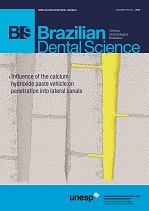Effect of enamel pretreatment on the fluoride remineralization of artificial white spot lesions
DOI:
https://doi.org/10.14295/bds.2018.v21i3.1585Resumo
Objective: The topical fluoride application is the main strategy to remineralize white spots lesions (WSL). It is assumed that increasing its retention in the surface can favor remineralization. Therefore, previous treatments of the enamel surface are purposed to optimize its efficacy. This study aimed to evaluate the remineralization capacity of the fluoride without and with the pre-treatment of the enamel with phosphoric acid and aluminum nitrate and then, the enamel acid-resistance after new acid challenge. Material and Methods: Twenty-four enamel bovine blocks were obtained and selected by means of initial surface microhardness (SMH) measurements. In sequence, WSL were artificially inducted by DE-RE cycling and randomized in two groups according to the enamel pretreatment to be tested (n=12): F (1.23% fluoride gel - APF- 4min) and P-Al-F (37% phosphoric acid- 30s + 0.05M aluminum nitrate 1min + APF- 4min). After then, a new acid challenge was equally performed. Additional SMH assessments were performed in each step. The values were processed and the percentage of SH loss (%SHL) was obtained. Data were statically analyzed by two-way ANOVA and Tukey tests (p<0.05). Results: There was no difference between evaluated protocols. For both groups, a significant difference among the steps of study was detected: it was observed a decrease of %SHL after the treatment and increase of %SHL after the new acid challenge. Conclusion: Enamel pretreatment with phosphoric acid associated with aluminum nitrate promoted similar protective effect compared to fluoride itself on the remineralization of artificial WSL, partially recovering the surface hardness. After new challenge, they also offered partial resistance.
Keywords
Dental caries; Dental enamel; Fluoride; Tooth remineralization.
Downloads
Downloads
Arquivos adicionais
Publicado
Como Citar
Edição
Seção
Licença
TRANSFERÊNCIA DE DIREITOS AUTORAIS E DECLARAÇÃO DE RESPONSABILIDADE
Toda a propriedade de direitos autorais do artigo "____________________________________________________________________" é transferido do autor(es) para a CIÊNCIA ODONTOLÓGICA BRASILEIRA, no caso do trabalho ser publicado. O artigo não foi publicado em outro lugar e não foi submetido simultaneamente para publicação em outra revista.
Vimos por meio deste, atestar que trabalho é original e não apresenta dados manipulados, fraude ou plágio. Fizemos contribuição científica significativa para o estudo e estamos cientes dos dados apresentados e de acordo com a versão final do artigo. Assumimos total responsabilidade pelos aspectos éticos do estudo.
Este texto deve ser impresso e assinado por todos os autores. A versão digitalizada deverá ser apresentada como arquivo suplementar durante o processo de submissão.




























